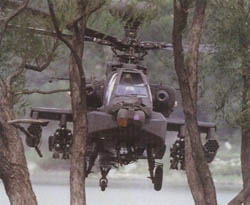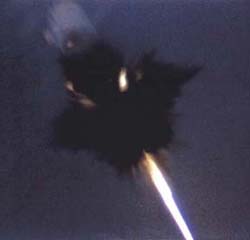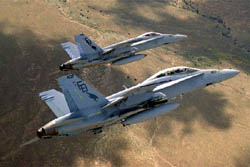Daily News
by Gail Helmer
[ Send Us News | Archives ]
Ubi Soft sent us new screenshots from the next squad-based action series, Tom Clancy's Rogue Spear: Black Thorn. The new screenshots show off some of the game's highly detailed 3D interior environments, as well as some of the weapons and character models that will be featured in the game. Black Thorn is a stand-alone mission pack that features a variety of missions, re-creating some of the most dangerous terrorist acts in history. It also includes a number of new weapons, such as the FAMAS assault rifle as well as six new multiplayer maps. Release date: October 2001.
Operation Flashpoint Patch Released
Codemasters has released an interim upgrade for Operation Flashpoint. The interim upgrade improves many aspects of the game and patches some of the known bugs. It also offers such enhancements as accurate shadow-casting for weapons and improved aircraft handling. New vehicles, weapons, single and multi-player missions will be available separately soon. Operation Flashpoint is available in Europe only, the North American release is set for September. Download now
Combat Command 2: Desert Rats Ships
Shrapnel Games announced today that Combat Command 2: Desert Rats will begin shipping today. Combat Command 2: Desert Rats covers the full spectrum of tactical desert warfare, from wild armored clashes ranging across the sands of Libya, to gritty, bare knuckles infantry combat in the rugged hills of Tunisia. Desert Rats allows you to fight the battles that made the Afrika Korps famous. Click here for further details.
Boeing and Lockheed Martin have agreed to begin incorporating new technology into the Arrowhead sensor system that will give the AH-64D Apache Longbow the world's most versatile and capable targeting and night-vision system suite by 2005.

Boeing and Lockheed Martin Missiles and Fire Control will work together to incorporate a large-format staring mid-wave (MW) forward-looking infrared (FLIR) sensor in the Arrowhead system for the Apache Longbow.
Boeing is the prime contractor on the multi-role combat helicopter, while Lockheed Martin is developing Arrowhead for the Apache Longbow.
The agreement comes at the end of studies conducted by both companies that looked at the validity of the technical approach and verified the cost-versus-benefit to the customer base.
Lockheed Martin developed the advanced-generation Arrowhead sensor suite as a follow-on replacement for the Target Acquisition Designation Sight/ Pilot Night Vision Sensor (TADS/PNVS) system it produced for all Apaches built to date by Boeing.
The core of the new upgrade for Arrowhead is the staring mid-wave integrated detector/cooler assembly (IDCA) that is identical to the IDCA used in Lockheed Martin's Sniper pod.
This new upgrade will complement the obscurant penetration of the existing long-wave sensor with a longer-range, smaller-field-of-view MW sensor. The combination will provide the Apache aircrew with improved electro-optical targeting performance in all conditions. The new MW electro-optical system can identify targets at greater ranges than the long-wave system. Proposed integration of this additional capability will follow the current AH-64D philosophy that enables autonomous, cooperative, and multiple sensor selection and display.
"The MW enhancements will improve the Arrowhead sensor suite without giving up any of its new-generation capabilities," said Al Winn, vice president of Apache Programmes for Boeing. "Lockheed Martin's new sensor suite already brings outstanding capabilities to the Apache Longbow. This addition will give Apache the best combined sensor package installed in any aircraft - rotary or fixed-wing."
Dave Shrum, programme director of the Arrowhead project at Lockheed Martin, said, "The US Army has future interest in further upgrading the Apache targeting system with this capability, and it has introduced this additional feature in its modernisation planning. We have agreed to work with Boeing in advance of an Army contract to implement this capability in the targeting sensor while maintaining all existing Arrowhead capabilities."
The MW FLIR was proposed to the US Army as an option in the TADS/PNVS modernisation competition conducted last year, but the option was not exercised at contract award because of funding constraints. Arrowhead is scheduled to be installed on Apache Longbow aircraft beginning in 2004. The proposed enhancements would be installed a short time thereafter.
Tom Mirek, technical director for Arrowhead at Lockheed Martin, added, "We designed Arrowhead from the start to accept additional upgrades such as this without the need for any redesign beyond the Direct View Optical Sensor. The end result will be an affordable enhancement at low risk for our customers."
The Apache Longbow is in production for the US Army and a number of defence forces world-wide. Nearly 1,200 AH-64A and AH-64D Apaches have been delivered.
BAE SYSTEMS Awarded 155mm BONUS Contract
BAE SYSTEMS has won a contract to supply 11,000 infra-red detectors for the BONUS 155mm artillery smart munition. BAE SYSTEMS is the largest manufacturer of infrared detectors in Europe with a capability that extends across a wide range of technologies and detector types.

BONUS is a joint Bofors Defence/GIAT Industries project. This smart munition is fired from conventional 155mm artillery systems. Once fired, at a given phase in its trajectory, the round separates to deploy two sub-munitions which use the detector to search for and attack targets within a given search footprint. Once a target is located the sub-munition then moves into the attack phase to destroy the target. If no targets are identified, the system self-destructs to avoid leaving live munitions on the battlefield.
The detector, made at BAE SYSTEMS Avionics, Tactical Systems Division, Southampton, transforms collected spectral energy into an electrical signal, by using an array of six photo-conductive Cadmium Mercury Telluride (CMT) elements, operating in two spectral wavebands. The array is cooled by a fast cooldown, two-stage thermoelectric cooler and all components are housed in a hermetically sealed encapsulation.
ITT ATC Radios For FAA
The Federal Aviation Administration (FAA) has awarded ITT Industries a $580 million contract to provide new Air Traffic Control (ATC) radios for the US National Airspace System. These radios will assist the FAA in providing communications services to the largest airspace system in the world.
With the system growing at a rate of 4% per year, the current analogue Air Traffic Control radio will reach full capacity in the next decade. In certain high-traffic areas like Atlanta, New York, Chicago and Los Angeles, the system will reach full capacity even earlier.
ITT Industries and its teammates Park Air Systems, Federal Data Corporation and Operational Technologies Services, Inc. will produce the ITT/Park Air CAVU 2100 Multi-mode Digital Radio (MDR) to be part of the FAA's Next Generation Communications Programme (NEXCOM). The radio incorporates the latest technological advances including the ability to simultaneously transmit voice and data link communications. When fully fielded, over 37,000 radios will be installed throughout the United States.
The ITT/Park Air CAVU 2100 MDR, which is designed to accommodate increasing future traffic networks, operates with both the current analogue radio system and the new International Civil Aviation Organisation endorsed digital link standard known as VDL-3.
Lou Dollive, president of ITT's Aerospace/Communications division in Ft. Wayne, Indiana, called the NEXCOM MDR award exciting. "We are building on our heritage of providing ATC communications to the FAA and more than 50 years of providing communications, surveillance and navigation systems to the world."
Atlantis Joins F/A-18 Upgrade Team
Atlantis Systems International has signed a contract with Boeing for engineering groundwork for the development of new technologies to be employed on the F/A- 18 Hornet Integrated Maintenance Trainer (IMTS) for the Canadian and Australian Armed Forces, as well as the refinement of specific RAAF and CF maintenance training requirements.

The IMTS is a multimedia tool for training F/A-18 maintenance personnel. The combination of a high fidelity replicated cockpit and virtual systems panels using SMART(C) technology provides an interactive instructional tool, as well as a non- threatening training environment. The system uses PC technology and can easily be re-configured for specific aircraft systems and uses.
The agreement allows Atlantis to optimise the IMTS system architecture for the F/A-18 IMTS development and production programme. The contract covers the initial development of the Canadian and Australian F-18 IMTSs. The total value of the IMTS project is estimated to be in excess of US$15,000,000.
The F/A-18 Hornet is a multi-mission tactical aircraft, designed from its inception to carry out both air-to-air and air-to-ground missions. It is in service with Canada, Australia, the US Navy, US Marine Corps and the air forces of Spain, Kuwait, Finland, Switzerland, and Malaysia. The Canadian and Australian Forces are currently planning aircraft modernisation programmes that would significantly upgrade the avionics of their F/A-18s.
[ Send Us News | Archives ]
by Gail Helmer
Wednesday August 1, 2001
- New Rogue Spear: Black Thorn Screens
- Operation Flashpoint Patch Released
- Combat Command 2: Desert Rats Ships
- Boeing, Lockheed Martin To Enhance Arrowhead Sensor Suite
- BAE SYSTEMS Awarded 155mm BONUS Contract
- ITT ATC Radios For FAA
- Atlantis Joins F/A-18 Upgrade Team
PC News
New Rogue Spear: Black Thorn ScreensUbi Soft sent us new screenshots from the next squad-based action series, Tom Clancy's Rogue Spear: Black Thorn. The new screenshots show off some of the game's highly detailed 3D interior environments, as well as some of the weapons and character models that will be featured in the game. Black Thorn is a stand-alone mission pack that features a variety of missions, re-creating some of the most dangerous terrorist acts in history. It also includes a number of new weapons, such as the FAMAS assault rifle as well as six new multiplayer maps. Release date: October 2001.
Operation Flashpoint Patch Released
Codemasters has released an interim upgrade for Operation Flashpoint. The interim upgrade improves many aspects of the game and patches some of the known bugs. It also offers such enhancements as accurate shadow-casting for weapons and improved aircraft handling. New vehicles, weapons, single and multi-player missions will be available separately soon. Operation Flashpoint is available in Europe only, the North American release is set for September. Download now
Combat Command 2: Desert Rats Ships
Shrapnel Games announced today that Combat Command 2: Desert Rats will begin shipping today. Combat Command 2: Desert Rats covers the full spectrum of tactical desert warfare, from wild armored clashes ranging across the sands of Libya, to gritty, bare knuckles infantry combat in the rugged hills of Tunisia. Desert Rats allows you to fight the battles that made the Afrika Korps famous. Click here for further details.
Military News
Boeing, Lockheed Martin To Enhance Arrowhead Sensor SuiteBoeing and Lockheed Martin have agreed to begin incorporating new technology into the Arrowhead sensor system that will give the AH-64D Apache Longbow the world's most versatile and capable targeting and night-vision system suite by 2005.

Boeing and Lockheed Martin Missiles and Fire Control will work together to incorporate a large-format staring mid-wave (MW) forward-looking infrared (FLIR) sensor in the Arrowhead system for the Apache Longbow.
Boeing is the prime contractor on the multi-role combat helicopter, while Lockheed Martin is developing Arrowhead for the Apache Longbow.
The agreement comes at the end of studies conducted by both companies that looked at the validity of the technical approach and verified the cost-versus-benefit to the customer base.
Lockheed Martin developed the advanced-generation Arrowhead sensor suite as a follow-on replacement for the Target Acquisition Designation Sight/ Pilot Night Vision Sensor (TADS/PNVS) system it produced for all Apaches built to date by Boeing.
The core of the new upgrade for Arrowhead is the staring mid-wave integrated detector/cooler assembly (IDCA) that is identical to the IDCA used in Lockheed Martin's Sniper pod.
This new upgrade will complement the obscurant penetration of the existing long-wave sensor with a longer-range, smaller-field-of-view MW sensor. The combination will provide the Apache aircrew with improved electro-optical targeting performance in all conditions. The new MW electro-optical system can identify targets at greater ranges than the long-wave system. Proposed integration of this additional capability will follow the current AH-64D philosophy that enables autonomous, cooperative, and multiple sensor selection and display.
"The MW enhancements will improve the Arrowhead sensor suite without giving up any of its new-generation capabilities," said Al Winn, vice president of Apache Programmes for Boeing. "Lockheed Martin's new sensor suite already brings outstanding capabilities to the Apache Longbow. This addition will give Apache the best combined sensor package installed in any aircraft - rotary or fixed-wing."
Dave Shrum, programme director of the Arrowhead project at Lockheed Martin, said, "The US Army has future interest in further upgrading the Apache targeting system with this capability, and it has introduced this additional feature in its modernisation planning. We have agreed to work with Boeing in advance of an Army contract to implement this capability in the targeting sensor while maintaining all existing Arrowhead capabilities."
The MW FLIR was proposed to the US Army as an option in the TADS/PNVS modernisation competition conducted last year, but the option was not exercised at contract award because of funding constraints. Arrowhead is scheduled to be installed on Apache Longbow aircraft beginning in 2004. The proposed enhancements would be installed a short time thereafter.
Tom Mirek, technical director for Arrowhead at Lockheed Martin, added, "We designed Arrowhead from the start to accept additional upgrades such as this without the need for any redesign beyond the Direct View Optical Sensor. The end result will be an affordable enhancement at low risk for our customers."
The Apache Longbow is in production for the US Army and a number of defence forces world-wide. Nearly 1,200 AH-64A and AH-64D Apaches have been delivered.
BAE SYSTEMS Awarded 155mm BONUS Contract
BAE SYSTEMS has won a contract to supply 11,000 infra-red detectors for the BONUS 155mm artillery smart munition. BAE SYSTEMS is the largest manufacturer of infrared detectors in Europe with a capability that extends across a wide range of technologies and detector types.

BONUS is a joint Bofors Defence/GIAT Industries project. This smart munition is fired from conventional 155mm artillery systems. Once fired, at a given phase in its trajectory, the round separates to deploy two sub-munitions which use the detector to search for and attack targets within a given search footprint. Once a target is located the sub-munition then moves into the attack phase to destroy the target. If no targets are identified, the system self-destructs to avoid leaving live munitions on the battlefield.
The detector, made at BAE SYSTEMS Avionics, Tactical Systems Division, Southampton, transforms collected spectral energy into an electrical signal, by using an array of six photo-conductive Cadmium Mercury Telluride (CMT) elements, operating in two spectral wavebands. The array is cooled by a fast cooldown, two-stage thermoelectric cooler and all components are housed in a hermetically sealed encapsulation.
ITT ATC Radios For FAA
The Federal Aviation Administration (FAA) has awarded ITT Industries a $580 million contract to provide new Air Traffic Control (ATC) radios for the US National Airspace System. These radios will assist the FAA in providing communications services to the largest airspace system in the world.
With the system growing at a rate of 4% per year, the current analogue Air Traffic Control radio will reach full capacity in the next decade. In certain high-traffic areas like Atlanta, New York, Chicago and Los Angeles, the system will reach full capacity even earlier.
ITT Industries and its teammates Park Air Systems, Federal Data Corporation and Operational Technologies Services, Inc. will produce the ITT/Park Air CAVU 2100 Multi-mode Digital Radio (MDR) to be part of the FAA's Next Generation Communications Programme (NEXCOM). The radio incorporates the latest technological advances including the ability to simultaneously transmit voice and data link communications. When fully fielded, over 37,000 radios will be installed throughout the United States.
The ITT/Park Air CAVU 2100 MDR, which is designed to accommodate increasing future traffic networks, operates with both the current analogue radio system and the new International Civil Aviation Organisation endorsed digital link standard known as VDL-3.
Lou Dollive, president of ITT's Aerospace/Communications division in Ft. Wayne, Indiana, called the NEXCOM MDR award exciting. "We are building on our heritage of providing ATC communications to the FAA and more than 50 years of providing communications, surveillance and navigation systems to the world."
Atlantis Joins F/A-18 Upgrade Team
Atlantis Systems International has signed a contract with Boeing for engineering groundwork for the development of new technologies to be employed on the F/A- 18 Hornet Integrated Maintenance Trainer (IMTS) for the Canadian and Australian Armed Forces, as well as the refinement of specific RAAF and CF maintenance training requirements.

The IMTS is a multimedia tool for training F/A-18 maintenance personnel. The combination of a high fidelity replicated cockpit and virtual systems panels using SMART(C) technology provides an interactive instructional tool, as well as a non- threatening training environment. The system uses PC technology and can easily be re-configured for specific aircraft systems and uses.
The agreement allows Atlantis to optimise the IMTS system architecture for the F/A-18 IMTS development and production programme. The contract covers the initial development of the Canadian and Australian F-18 IMTSs. The total value of the IMTS project is estimated to be in excess of US$15,000,000.
The F/A-18 Hornet is a multi-mission tactical aircraft, designed from its inception to carry out both air-to-air and air-to-ground missions. It is in service with Canada, Australia, the US Navy, US Marine Corps and the air forces of Spain, Kuwait, Finland, Switzerland, and Malaysia. The Canadian and Australian Forces are currently planning aircraft modernisation programmes that would significantly upgrade the avionics of their F/A-18s.
